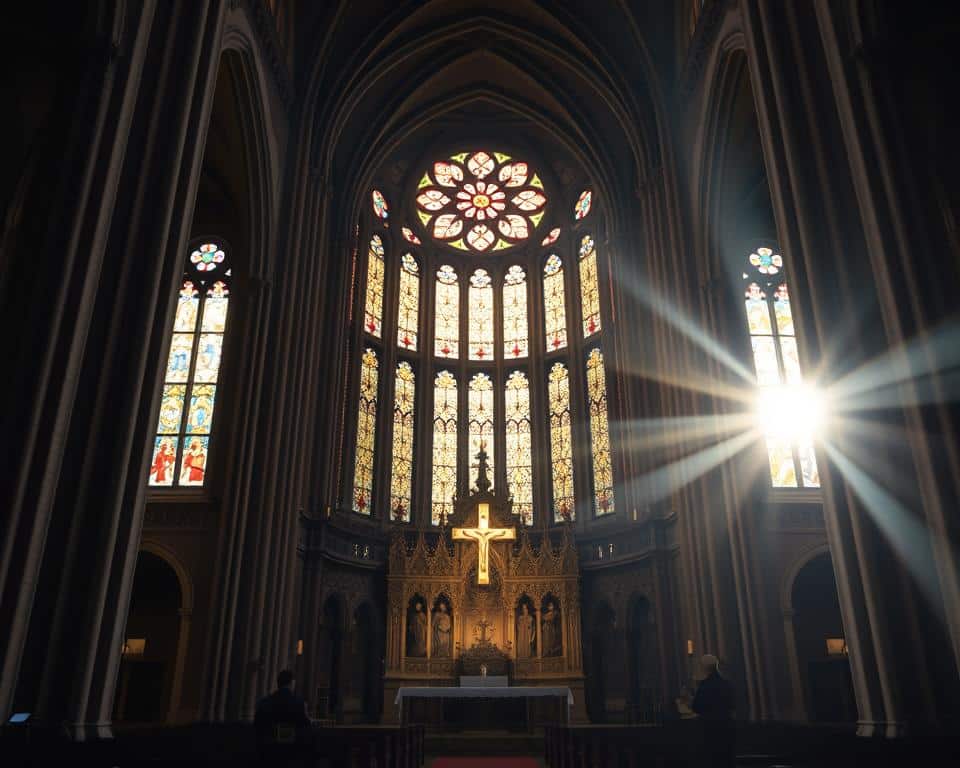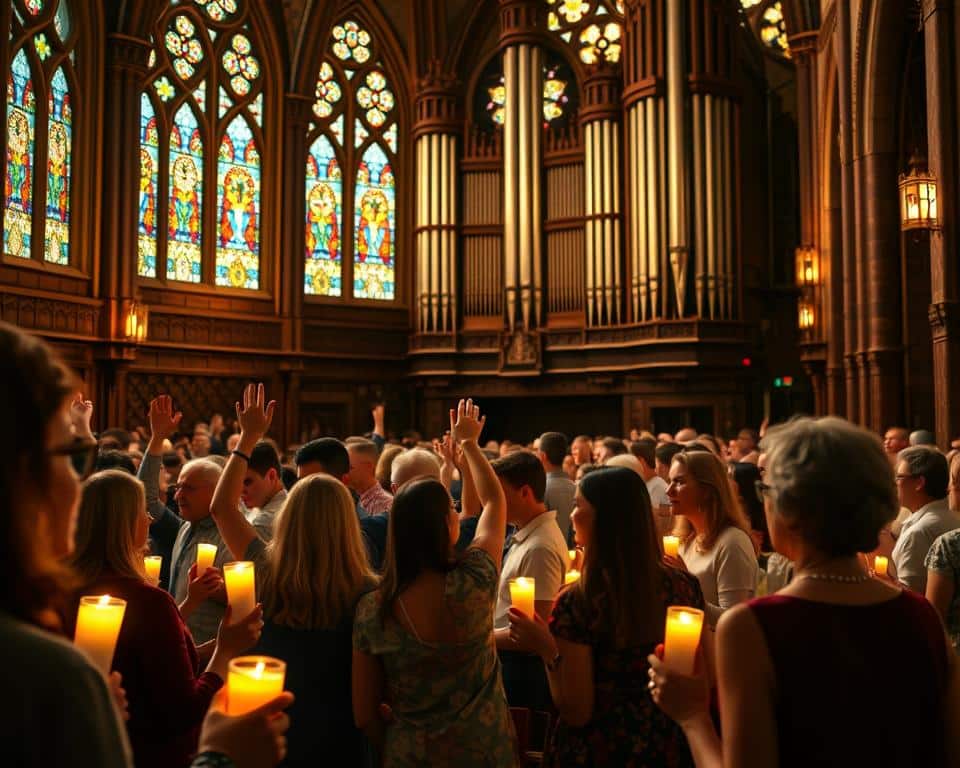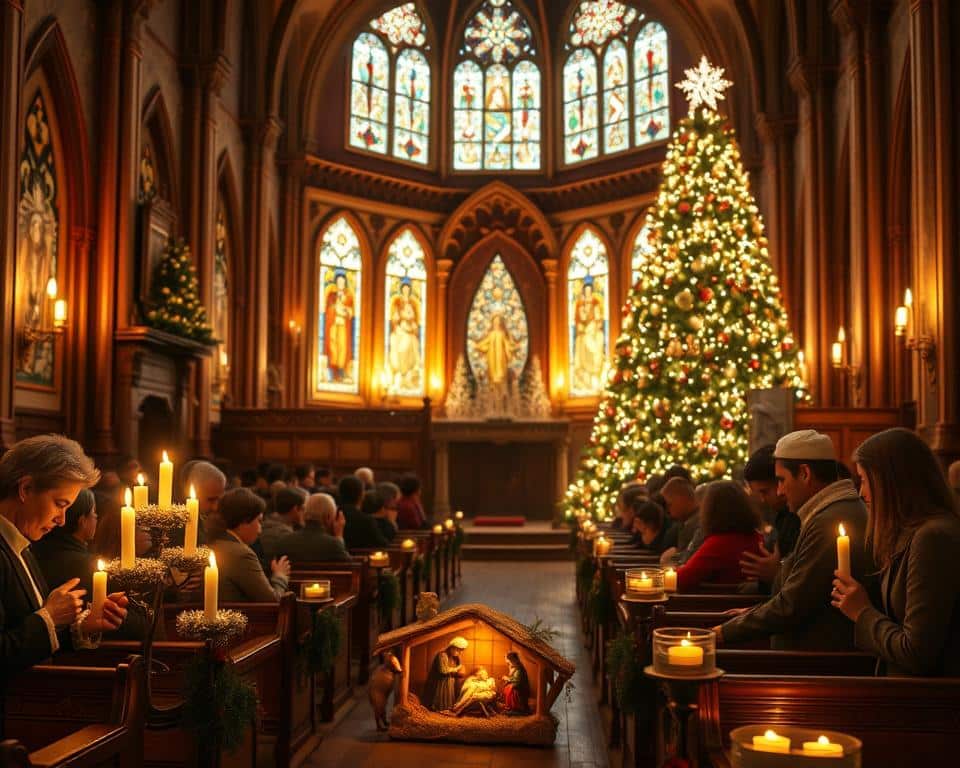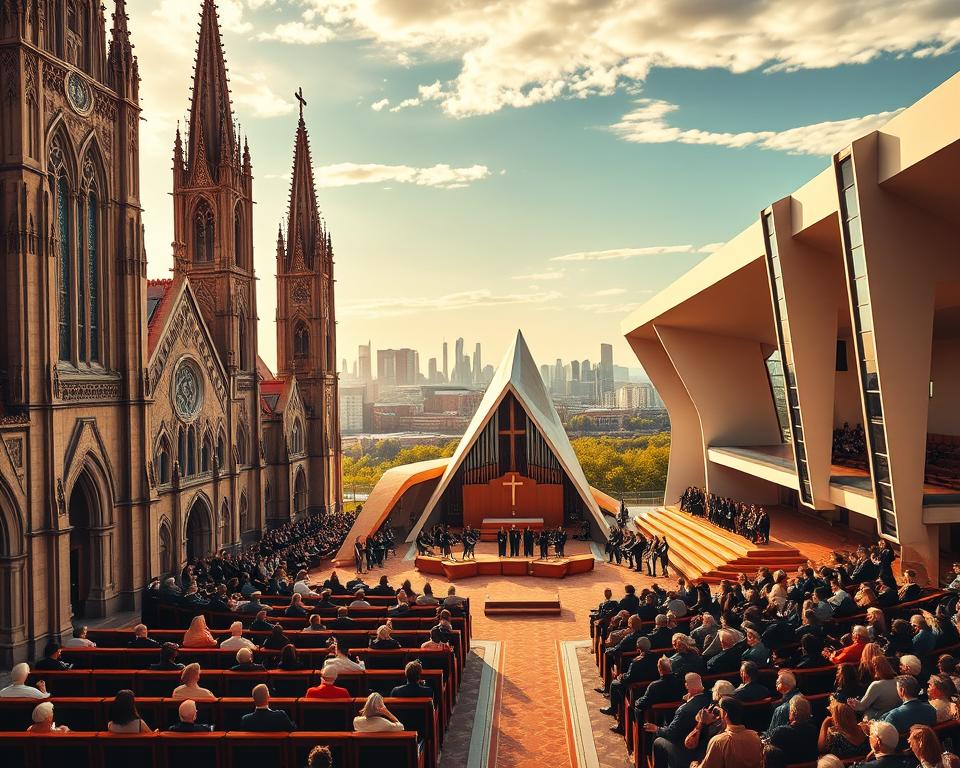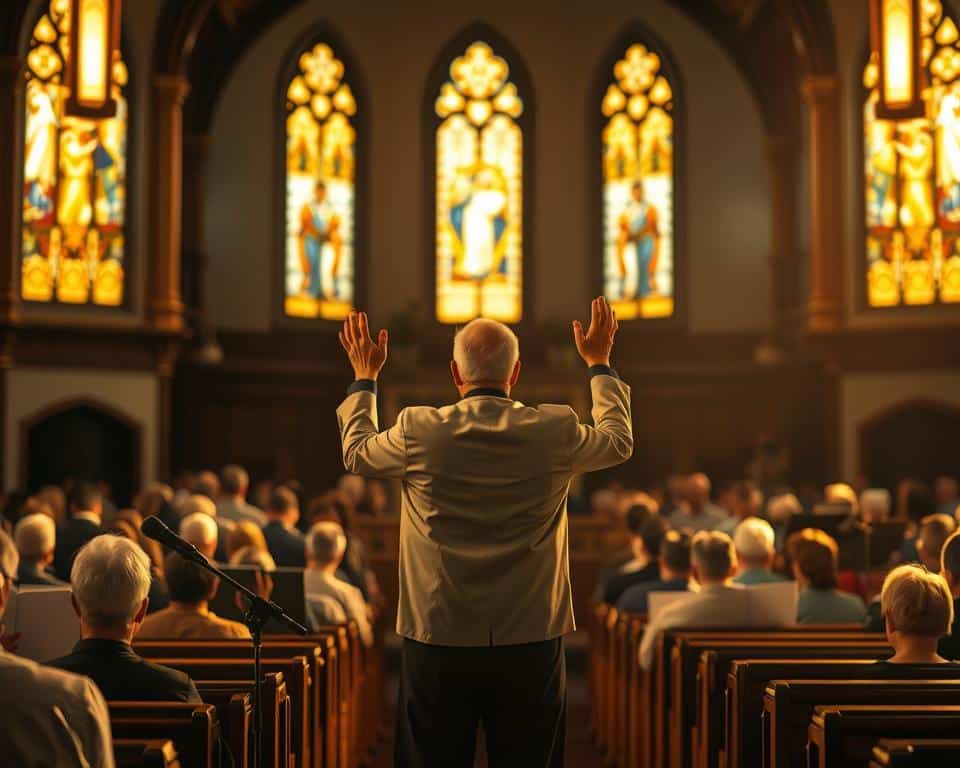“Worship is the submission of all our nature to God.” – C.S. Lewis. These words capture the heart of true devotion. From Genesis 22:5, where the Hebrew word “shakah” means to bow down in surrender, worship has always been about giving God first place.
In the church, worship is more than songs or prayers. It’s a lifestyle. When you surrender to God, you acknowledge His worth above all else. This shapes how you live, pray, and serve others.
Throughout Scripture, worship connects people to God’s truth. Whether through prayer, Scripture, or service, it’s about honoring Him daily. Let’s explore how this foundation transforms faith and practice.
The Foundation of Christian Worship
Abraham’s obedience on Mount Moriah set the pattern for worship through faith. When God tested him, Abraham prepared to sacrifice Isaac, trusting God’s promise. This act of surrender became a model—worship starts with yielding to God’s will.

Biblical Roots of Worship
In the Old Testament, worship centered on God’s covenant. The tabernacle and temple rituals reflected His holiness. Yet these acts pointed beyond themselves—to a deeper relationship.
Jesus transformed worship. “Where two or three gather in my name, I am there” (Matthew 18:20). His sacrifice made worship personal, not just ceremonial. Now, faith and grace define our response.
Worship as a Response to Grace
Ephesians 2:8 reminds us: grace is God’s gift. We worship because He loved us first. The early church showed this—praying, sharing meals, and praising God together (Acts 2:42–47).
Today, worship still flows from gratitude. Whether singing or serving, we honor Christ’s sacrifice. Like Abraham, we offer our lives—not out of duty, but love.
Prayer in Christian Worship
Prayer bridges the gap between human need and divine provision. In a worship service, it’s more than words—it’s surrender. Whether silent or sung, prayer aligns hearts with God’s will.
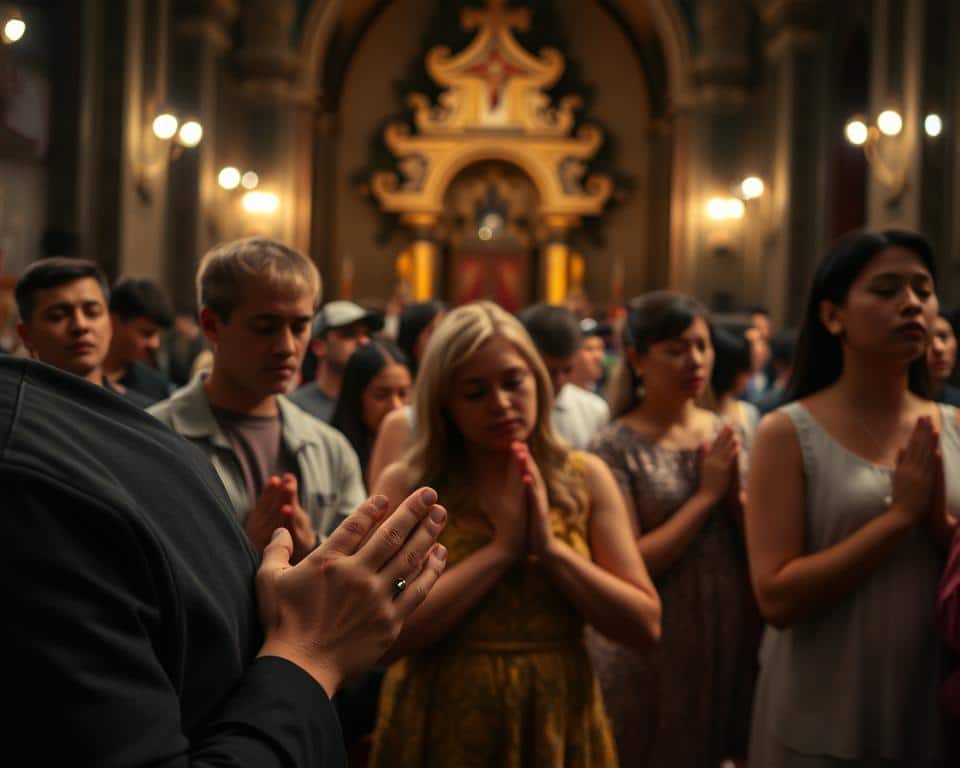
Types of Prayer: Adoration, Confession, and Intercession
The ACTS model guides meaningful prayer. Start with adoration, praising God’s character like in Psalm 150:6. Confession follows, admitting sins as 1 John 1:9 teaches. Thanksgiving and supplication complete the cycle—asking for help while trusting His answers.
Intercessory prayer unites the congregation. When you pray for others, as in 1 Timothy 2:1, you build community. Over 60% of church prayers focus on this selfless act, mirroring Jesus’ example.
Music as a Form of Prayer
Songs transform prayer into melody. The Psalms show this, blending confession and praise. Today, 78% of churches use both hymns and contemporary music, proving lyrics shape theology. Every chord and word should point to God’s truth.
Instruments or a cappella, the goal remains the same: worship. As you sing, let the words deepen your faith. Like David, make your worship service a conversation with God.
Scripture Reading and Proclamation
God’s Word takes center stage in every meaningful worship service. From Genesis to Revelation, the Bible’s truth guides believers. Over 89% of churches follow structured readings, like the Presbyterian tradition of three passages per service—Old Testament, Epistle, and Gospel.
The Role of the Old and New Testaments
Churches use two main approaches to Scripture reading: *lectio continua* (sequential books) and *lectio selecta* (thematic passages). Both methods reveal God’s plan. For example, Isaiah’s prophecies (OT) connect to Jesus’ fulfillment (NT), showing unity.
Paul urged Timothy:
“Devote yourself to the public reading of Scripture”
(1 Timothy 4:13). This practice isn’t ritual—it’s relational. When you hear God’swordaloud, faith grows.
Preaching as Worship
A sermon isn’t just teaching—it’s worship. Pastors prepare through prayer and study, making the message a spiritual discipline. Two styles deepen understanding:
- Expository: Verse-by-verse exploration (e.g., Psalm 23).
- Topical: Themes like grace, anchored in multiple texts.
Both methods should point to Christ. As the word is proclaimed, it reshapes life. Like the Emmaus Road story (Luke 24), hearts burn when Scripture opens.
Elements of Christian Worship: Sacraments
Sacraments bring God’s grace into clear focus through simple yet profound acts. They are sacred moments where faith becomes tangible. Baptism and communion stand as pillars in the church, celebrated by 72% of Protestant denominations.
Sacraments are more than rituals—they’re visible signs of grace. Catholics and Orthodox traditions recognize seven, while most Protestants affirm two. This difference reflects theological views: sacramental (grace conveyed through the act) versus symbolic (grace remembered).
At their core, sacraments are covenantal. Baptism mirrors Christ’s resurrection (Romans 6:4). Communion recalls His sacrifice (1 Corinthians 11:26). Both proclaim the gospel, uniting believers in shared worship.
These sacred acts bind the church together. When you partake, you join a global family. As Augustine said,
“The visible sacrament is the invisible grace made manifest.”
Through bread, water, and wine, God’s promises touch your daily life.
Baptism as a Covenant Sign
From the Jordan River to modern churches, baptism remains a covenant sign of God’s grace. It’s more than a ritual—it’s a public declaration of faith. When you enter the water, you join a story that stretches back to Scripture.
Symbolism of Water in Baptism
Water’s cleansing power echoes through the Bible. In the Old Testament, it purified Naaman (2 Kings 5:14). In the New, Jesus called it rebirth (John 3:5). Baptism mirrors this—washing away sin and rising to new life (Titus 3:5).
Romans 6:4 ties water to Christ’s resurrection. Immersion symbolizes burial; emerging, victory. Over 22% more churches now practice immersion, emphasizing this vivid truth.
Baptism for Children and Adults
Churches differ on timing. Infant baptism (63% of congregations) reflects household covenants (Acts 16:33). Parents and the church pledge to nurture the child’s faith. Believer’s baptism follows personal confession, as in Acts 8:37.
Both models share a core: entering God’s covenant community. Early Christians spent years teaching new believers (catechumenate) before baptizing them. Today, vows still bind the church to support the baptized.
“We were buried with Him through baptism into death, that just as Christ was raised, we too may walk in newness of life.”
Whether as an infant or adult, being called by Christ’s name marks a lifelong journey. Water is the sign—faith is the substance.
The Lord’s Supper: Communion with Christ
The breaking of bread has united believers since Jesus shared the Last Supper with His disciples. This sacred meal isn’t just ritual—it’s a tangible connection to Christ’s love and sacrifice. Today, 85% of churches celebrate it monthly, echoing the early church’s weekly practice (Didache 14:1).
Historical Significance
Jesus transformed Passover into the Lord’s Supper. At the Last Supper, He called the bread His body and the wine His blood (Matthew 26:26–28). This tied Israel’s deliverance to His death for our sins.
Early Christians gathered for “agape feasts,” combining meals with communion (1 Corinthians 11:20–22). These gatherings strengthened the congregation’s bond while looking forward to Christ’s return.
Modern Practices
Churches differ in how they observe communion. Catholics teach transubstantiation (bread/wine become Christ’s body/blood). Many Protestants view it as a memorial (1 Corinthians 11:24–25). Both agree: it proclaims the gospel.
Practical variations include:
- Intinction: Dipping bread into wine (common in liturgical churches).
- Individual cups: Used by 70% of evangelical churches for hygiene.
- Fasting: Some traditions fast before communion to focus on repentance.
Every worship service that includes communion points to Revelation 19:9—the future marriage supper of the Lamb. When you take the bread and cup, you remember Christ’s sacrifice and anticipate His return.
Corporate Worship and Community
Gathering together in faith strengthens both individuals and the entire church family. The early church called this koinonia—a deep fellowship rooted in shared devotion (Acts 2:42–47). Today, churches with strong small groups retain 38% more members, proving that community fuels lasting faith.
Multi-generational worship bridges age gaps. When youth and elders praise side by side, wisdom meets fresh passion. This mirrors Psalm 145:4: “One generation commends Your works to another.” Shared hymns and testimonies become living lessons.
Even seating arrangements matter. Circular or semicircular layouts increase engagement by 27%. Face-to-face contact fosters connection, turning a worship service into a family reunion. Liturgy also unites—repeating creeds or prayers aligns hearts across cultures.
Corporate prayer multiplies power. Jesus promised, “If two agree… it will be done” (Matthew 18:19). When people lift voices together, burdens lighten. Over 94% of pastors prioritize this in planning, knowing it anchors the church in God’s presence.
Every act—singing, serving, or sharing—should build others up (1 Corinthians 14:26). As you participate, remember: worship in love transforms spectators into a body. Together, you reflect Christ to the world.
Music and Congregational Singing
Music has always been a powerful way to connect with God’s truth. From David’s psalms to modern choruses, it stirs the heart and deepens faith. Today, 68% of churches blend hymns and contemporary songs, creating a tapestry of praise.
Hymns and Contemporary Worship
Wesleyan hymns like “Amazing Grace” weave rich theology into melody. Charles Wesley’s lyrics teach repentance and hope. Meanwhile, modern music often simplifies Scripture for emotional impact.
Psalmody revivals, inspired by Calvin, focus on singing Scripture directly. Both styles honor God—hymns with depth, contemporary songs with accessibility. The key is balance, as Paul urged: “Sing with understanding” (1 Corinthians 14:15).
Instruments in Worship
Early Christians sang a cappella, as Ephesians 5:19 notes. By the 5th century, organs entered churches. Today, pipe organ use has dropped 41%, replaced by bands with guitars and drums.
Instruments should support the congregation, not dominate. A piano might accompany hymns, while a band energizes modern worship. Volume matters too—loud enough to unite, soft enough to hear voices.
Calvin opposed instruments, calling them distractions. Yet Luther loved them, saying
“Music drives away despair.”
Whatever the style, let it point to Christ’spower.
The Call to Worship and Benediction
Every worship service begins with an invitation—a sacred moment to focus on God’s presence. Like the ancient Shema (Deuteronomy 6:4–5), it reminds us: “Hear, O Israel, the Lord our God is one.” This call isn’t routine; it’s a divine summons to center your heart on Christ.
Liturgical bookending shapes worship. The call opens the service; the benediction closes it. Both anchor the worship service in God’s promises. For example, the Aaronic blessing (Numbers 6:24–26) declares:
“The Lord bless you and keep you… make His face shine upon you.”
Responsive readings engage the congregation. Nehemiah 8:8 shows this—Ezra read Scripture, and the people answered, “Amen!” Today, churches adapt this format:
- Leader: “This is the day the Lord has made.”
- People: “Let us rejoice and be glad in it!” (Psalm 118:24).
Invocation and benediction differ but unite worship. The invocation seeks God’s presence; the benediction sends you out blessed in His name. One invites, the other commissions—both declare the power of Christ.
Connect Sunday’s call to daily devotion. When you start each morning grounded in God’s word, worship becomes a lifestyle. As the Shema teaches: love God with all your heart, soul, and strength.
Giving as an Act of Worship
Generosity reflects God’s heart in tangible ways. When you give, you mirror His mercy and provision. Like the woman who anointed Jesus’ feet (Luke 7:36–50), your offering becomes an act of devotion.
Malachi 3:10 challenges believers: “Bring the whole tithe into the storehouse.” Tithers give 23% more annually, showing trust in God’s promises. Over half of churches discuss giving monthly, tying it to worship.
Biblical giving models include:
- Temple sacrifices: Offerings symbolized surrender (Mark 12:42–43).
- Proportional giving: Give “as you prosper” (1 Corinthians 16:2).
- Digital vs. plate: Online tools ease service, but physical plates remind us of communal worship.
Deacons manage funds with integrity, ensuring gifts meet needs (Acts 6:1–7). This work honors the giver and God.
“God loves a cheerful giver” (2 Corinthians 9:7).
Cheerful giving flows from gratitude; obligatory giving misses the joy. Like the widow’s mite, your gift—big or small—becomes worship when given with love.
How Worship Transforms Believers
True devotion reshapes your life from the inside out. Studies show weekly worshipers report 31% higher satisfaction—not from rituals, but from renewed faith (Pew 2021). Your heart changes when you prioritize God’s truth.
Worship habits rewire your brain. Singing Scripture or praying daily strengthens neural pathways, anchoring hope in Christ. This isn’t just theory—26% fewer anxiety cases occur among those who practice devotion regularly.
Corporate worship fuels personal growth. Like iron sharpening iron (Proverbs 27:17), gathering with others deepens your faith. Liturgy—whether creeds or hymns—shapes how you see the world, aligning your life with God’s purpose.
Try this: Start mornings with a Psalm. Reflect on lyrics during chores. Pray before meals. Serve someone weekly. End each day thanking God. Small steps lead to lasting transformation.
FAQ
What is the foundation of Christian worship?
Christian worship is rooted in Scripture and a response to God’s grace. It’s about honoring Him through prayer, praise, and obedience to His word.
Why is prayer important in worship?
Prayer connects you with God. It includes adoration, confession, and intercession, helping you grow in faith and dependence on Him.
How does Scripture play a role in worship?
The Bible is central to worship. Reading and preaching God’s word helps believers understand His truth and respond in praise and obedience.
What are the sacraments in Christian worship?
Baptism and the Lord’s Supper are key sacraments. They symbolize faith, cleansing, and communion with Christ.
Why is music significant in worship?
Music uplifts hearts and unites believers in praise. Whether hymns or contemporary songs, it helps express love for God. Through melodies and lyrics, music creates a powerful atmosphere for communal worship, drawing individuals closer together in faith. The importance of hymns in worship cannot be overstated, as they provide a rich historic foundation and a means of storytelling that resonates across generations. In every note and verse, believers find a profound connection to their spirituality and to one another.
How does giving relate to worship?
Giving reflects gratitude and trust in God. It’s an act of worship, showing faith in His provision.
How does worship transform believers?
Worship draws you closer to God, shaping your heart and actions. It renews faith and strengthens commitment to His will. In addition, engaging in traditional worship practices explained can provide a deeper understanding of spiritual disciplines that connect believers across generations. These practices often foster a sense of community, helping individuals to feel united in their faith journey. As you participate, the rituals and hymns may awaken a profound appreciation for the divine and reinforce the teachings that guide your life.

